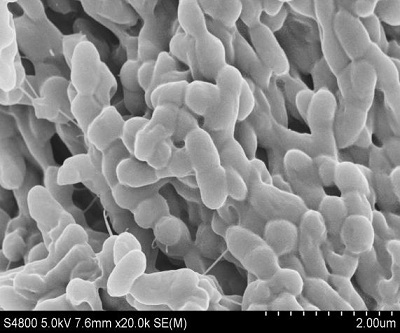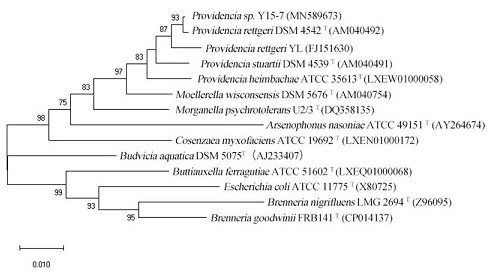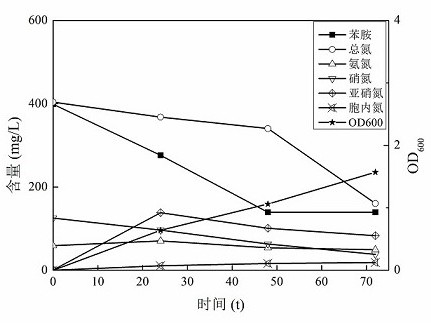A strain of Providencia rettgeri capable of degrading aniline and denitrification and its application
A technology of Providencia rettgeri and aniline, applied in the direction of bacteria, chemical instruments and methods, and methods based on microorganisms, can solve the problems of low salinity, no denitrification performance, and limited wastewater treatment, etc., and achieve broad The effect of applying the foreground
- Summary
- Abstract
- Description
- Claims
- Application Information
AI Technical Summary
Problems solved by technology
Method used
Image
Examples
Embodiment 1
[0024] Example 1 Screening, isolation and identification of bacterial strains capable of degrading aniline and denitrification:
[0025] Source of the strain: activated sludge of printing and dyeing wastewater
[0026] LB medium (g / L): bacteriological peptone 10, yeast extract 5, NaCl 10, distilled water, pH 7.0.
[0027] Screening and isolation method of bacterial strains: Take 10 mL of pretreated sludge, inoculate it into 90 mL of LB medium containing 200 mg / L aniline, and culture it in a shaker at 30°C and 160 r / min for 5 days . Then transfer to concentrations of 300 mg / L, 400 mg / L, 500 mg / L, 600 mg / L, 800 mg / L for acclimatization. Then, the sludge acclimatization culture solution was serially diluted in 10-fold increments, spread on the LB solid medium plate containing 200 mg / L aniline, and cultured in a biochemical incubator at 30°C to obtain a single colony. A single colony was picked and inoculated in the aniline degradation medium, and the aniline removal rate and T...
Embodiment 2
[0033] Example 2 Degradation and denitrification characteristics of strain Y15-7 to aniline under aerobic conditions
[0034] Seed medium for culturing strain Y15-7 (g / L): glucose 2, bacteriological peptone 1, yeast extract 0.5, NaCl 10, MgSO4•7H2O 0.5, KH2PO4 0.5, K2HPO4 1.5, KNO3 1.0, aniline 0.2, Distilled water, pH7.0.
[0035]The medium used to study the degradation ability of bacteria Y15-7 (g / L): glucose 2, bacteriological peptone 1, yeast extract 0.5, NaCl 10, MgSO4•7H2O 0.5, KH2PO4 0.5, K2HPO4 1.5, KNO3 1.0, aniline 0.4 , distilled water, pH7.0.
[0036] Inoculate the Y15-7 strain preserved on the plate into the seed medium, and cultivate it at 30°C and 160 r / min for 42 h to obtain the seed liquid; ℃, 160 r / min, aerobic aeration and shaking culture for 72 hours, samples were taken at different time points to determine the contents of aniline, total nitrogen, ammonia nitrogen, nitrate nitrogen, nitrite nitrogen, intracellular nitrogen and OD in the solution 600 , to...
Embodiment 3
[0037] Example 3 Degradation and denitrification efficiency of aniline by strain Y15-7 under different conditions of oxygen supply
[0038] Seed medium for culturing strain Y15-7 (g / L): glucose 2, bacteriological peptone 1, yeast extract 0.5, NaCl 10, MgSO4•7H2O 0.5, KH2PO4 0.5, K2HPO4 1.5, KNO3 1.0, aniline 0.2, Distilled water, pH7.0.
[0039] The medium used to study the degradation ability of bacteria Y15-7 (g / L): glucose 2, bacteriological peptone 1, yeast extract 0.5, NaCl 10, MgSO4•7H2O 0.5, KH2PO4 0.5, K2HPO4 1.5, KNO3 1.0, aniline 0.4 , distilled water, pH7.0.
[0040] Inoculate the Y15-7 strain preserved on the plate into the seed medium, and cultivate it at 30°C and 160 r / min for 48 hours to obtain the seed liquid; inoculate the seed liquid with 1% inoculum amount until it contains 400 mg / L aniline for degradation In the culture medium, different oxygen supply environments (strong aerobic, aerobic, anoxic) were created by changing the amount of the reactor solutio...
PUM
 Login to View More
Login to View More Abstract
Description
Claims
Application Information
 Login to View More
Login to View More - R&D
- Intellectual Property
- Life Sciences
- Materials
- Tech Scout
- Unparalleled Data Quality
- Higher Quality Content
- 60% Fewer Hallucinations
Browse by: Latest US Patents, China's latest patents, Technical Efficacy Thesaurus, Application Domain, Technology Topic, Popular Technical Reports.
© 2025 PatSnap. All rights reserved.Legal|Privacy policy|Modern Slavery Act Transparency Statement|Sitemap|About US| Contact US: help@patsnap.com



